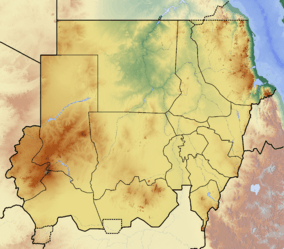Radom National Park
| Radom National Park | |
|---|---|
|
IUCN category II (national park) | |
 | |
| Coordinates | 9°10′N 24°0′E / 9.167°N 24.000°ECoordinates: 9°10′N 24°0′E / 9.167°N 24.000°E |
| Established | 1980 |
Radom National Park (alternate Al-Radom Reserve)[1] is a biosphere reserve in South Darfur, Sudan, Africa. It is 1,250,970 hectares (3,091,200 acres) in size.[2] The Adda and Umblasha Rivers form the park’s northern and southern boundaries.[3] Contiguous to Radom is the Andre Felix National Park of the Central African Republic.[3] Established as a park, it was designated in 1979 as a member of the World Network of Biosphere Reserves.
Rivers, streams, and permanent pools cover much of the park, which is characterized as a wooded savannah. Approximately 90% of the habitat is shrubland, while the remainder is forest.[3] Annual rainfall ranges between 900–1,700 millimetres (35–67 in); the mean annual relative humidity ranges between 57-65%; and the average annual temperature is 16-27 C. Major villages within the park include: Radom, Mesheitir, Bireikat, Um Gudul, Songo, al Hufra, Bimeza, Deim Gushara, Chili West, Majid, Dafag, Titribi, Kafindibei West, Kafindibei East, Amara, Um Hugaar, Kafiakingi, Karmandoura, and Shioulla.
Conservation issues
The park has suffered from commercial game poaching. Subsequent to the country's 1985 famine era, the Tora Hartebeest completely disappeared from the park.[4] The defassa waterbuck has also disappeared from the park.[5]
References
- ↑ "Antiquities and Tourism". Embassy of Sudan - the Hague. Retrieved 6 August 2011.
- ↑ "Biosphere Reserve Information - Sudan - Radom". UNESCO, MAB. August 7, 2007. Retrieved 6 August 2011.
- 1 2 3 "SD012 Radom". birdlife.org. Retrieved 6 August 2011.
- ↑ Hassan, Tarig Tag Elsir; Ameer Awad Mohammed; Nasir Yousif Gaboush (November 2005). "Sustainable Utilization of Wildlife Resources In Radom Biosphere Reserve (Final Report)" (PDF). UNESCO. pp. 6, 7, 13, 15. Retrieved 6 August 2011.
- ↑ East, Rod; International Union for Conservation of Nature and Natural Resources. Antelope Specialist Group (1 June 1999). African antelope database 1998. IUCN. pp. 65, 175–. ISBN 978-2-8317-0477-7. Retrieved 6 August 2011.